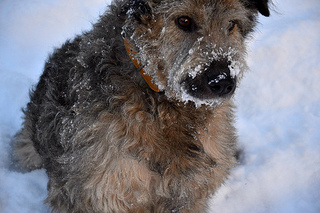Ever search online for Dog Myths Busted? As of this post, we discovered that the internet has at least 30 million pages on the topic.
Apparently these stories have been around for ages, and they are still popular today. So why post another?
1) We wanted a short-list of the most popular myths and the truth behind the legend.
2) We wanted to introduce you to a pet author so we revived this from her 2012 blog post.
3) We wanted to see if we could rank on Page 1 of the search engines like we did with our last post on Dog Cold Weather Tips (also very popular, but we made it–do an exact search by searching Dog Cold Weather Tips in quotes) or if that was a fluke.
So lets get those dog myths busted…
Myth 1 “A dog is a carnivore. Look at his teeth!”
Truth: There is much confusion out there in the pet world about what is the best diet to feed a dog. Many dog lovers insist on feeding their canine friends a pure meat diet because they think their dog is designed to be a pure carnivore. A better understanding of the definitions associated with the dietary needs of animals is a great place to start in understanding how to best feed your pet and tackle this hotly debated myth.
DEFINITIONS
CARNIVORE: An animal subsisting primarily on animal tissue.
HERBIVORE: An animal subsisting entirely on plant tissue.
OMNIVORE: An animal subsisting on both animal and plant tissue.
Cats and dogs are both members of the taxonomic order Carnivora. The confusing part is not all species of the Carnivora order are actually carnivores.
Cats are true carnivores because they have a higher protein requirement and higher dietary requirements for nutrients that aren’t available from plant sources, such as taurine, arginine, and methionine.
Some Carnivora species, including dogs, coyotes and bears, are omnivores that thrive on a diet consisting of both plant and animal tissue.
One member of the Carnivora order, the panda, is primarily an herbivore – 99% of a panda’s diet consists of bamboo.
The truth to this myth is dogs belong to the taxonomic order Carnivora, but their behavior, anatomy, and feeding preferences reveal their ability to eat and be healthy on a diet consisting of both plant and animal foods, which classifies them as omnivores from a dietary perspective (Debraekeleer et al. 2010).
Myth 2: “My dog’s nose is dry and warm. He must have a fever.”
Truth: As with most ‘old wives’ tales’, there is some truth rooted in this myth. Back before vaccines, thickened, hard and crusty nose and footpads were sure signs of advanced Distemper virus in a canine. Thanks to widespread vaccination practices, while Distemper still exists, it is far less common today.
The truth is a dog’s nose fluctuates in temperature and moisture throughout the day depending on what he is doing. A dog’s nose is often warm and dry when he wakes up, is moist and cold if he is eating or sniffing, and dry and warm if he is sleeping – all in the same day. And all of these fluctuations are normal. A dog with a fever often displays other signs, such as lethargy, inappetence (which occurs when pets won’t eat or won’t eat as much as they need), coughing, sneezing, vomiting or diarrhea as well as a dry warm nose. However, a nose that is persistently dry and crusted, is bleeding or turning a different color may be a sign of a health problem. If you notice any of these signs, contact your veterinarian right away.
Myth 3: “Dogs are colorblind.”
Truth: Not so, say canine researchers. If, however, what you mean by colorblind is that dogs only see a portion of the visible spectrum compared to what people see, then yes, dogs could be called colorblind.
Dogs have two types of color receptors on the back of their eyes that recognize short and long wavelengths of light, corresponding to blue hues and red-yellow ones. In comparison, humans have three types of color receptors that make it possible for us to see a full range of colors. The colors dogs can see are almost identical to the ones a human who has red-green color blindness would see. Scientists determine this by shining beams of colored light into dogs eyes, analyzing the spectrum of light that is reflected back, and then comparing the spectrum with the pattern produced when the same lights are shined into human eyes. Scientists also study the way dogs respond to different colored lights, and have determined that dogs see in black, white, red-yellow, blue and many shades of gray.
It’s also interesting to note that dogs can see much better in low light than humans, can distinguish moving objects much better than stationary ones, and long-nosed breeds have very wide fields of vision, as much as 270 degrees.
Myth 4: “My dog’s happy. I can tell because his tail is wagging.”
While it is true that when a dog is happy, he will often wag his tail, but a wagging tail can also indicate agitation – such as an imminent attack – or even aggression. It all depends on two factors – the position of the tail and the frequency of the wag. A friendly, approachable, happy dog usually wags his tail – generally positioned in the middle of his body – slowly and loosely. If a dog is wagging his tail in a more rapid, twitch-like manner and is about 90 degrees high, it’s best to avoid the animal, as it could be indicating dominance and aggression. Conversely, if a dog’s tail is wagging low between the legs, it is considered a fearful, defensive stance.
Just like in humans, many factors come into play when interpreting a dog’s mood. Be sure to assess all of your pet’s body language, including the position of their ears and head as well as their expression and hackles before approaching him – this way, everyone’s happy.
Myth 5: “A dog ages 7 years for every human year.”
Although it is true that dogs age more rapidly than humans, which makes perfect sense since they are able to reproduce before they even reach one year of age, the rate that they age slows down as the dog ages. Stating that one human year equals seven dog years is an over-simplification of how dogs age. There’s simply no exact formula to determine a dog’s “human” age.
It’s important to note that the size and breed of the dog are the greatest indicators of the rate of aging. Many small breed dogs can live well into their 20s while larger breeds tend to live only 7-10 years – despite the fact that large breed puppies reach adulthood slower than their smaller counterparts.
Now that you know the truth, you’re on the path to becoming an even more well-informed pet parent! Share what you’ve learned with your animal-loving friends and help stop the spread of misinformation – your animal companions will thank you for it!
Click the More button to go to our mystery writer….you can leave your comments there or add your tips below for our readers.
From our mystery guest and everyone at SmallDogsUSA.org, Thank You so much for all you do to make the world a better place for companion animals!


